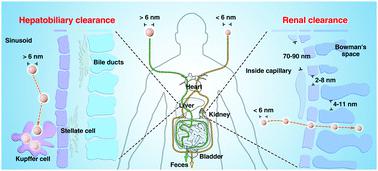当前位置:
X-MOL 学术
›
Chem. Soc. Rev.
›
论文详情
Our official English website, www.x-mol.net, welcomes your
feedback! (Note: you will need to create a separate account there.)
Inorganic nanomaterials with rapid clearance for biomedical applications
Chemical Society Reviews ( IF 40.4 ) Pub Date : 2021-6-22 , DOI: 10.1039/d0cs00461h Xianwen Wang 1 , Xiaoyan Zhong , Jianxiang Li , Zhuang Liu , Liang Cheng
Chemical Society Reviews ( IF 40.4 ) Pub Date : 2021-6-22 , DOI: 10.1039/d0cs00461h Xianwen Wang 1 , Xiaoyan Zhong , Jianxiang Li , Zhuang Liu , Liang Cheng
Affiliation

|
Inorganic nanomaterials that have inherently exceptional physicochemical properties (e.g., catalytic, optical, thermal, electrical, or magnetic performance) that can provide desirable functionality (e.g., drug delivery, diagnostics, imaging, or therapy) have considerable potential for application in the field of biomedicine. However, toxicity can be caused by the long-term, non-specific accumulation of these inorganic nanomaterials in healthy tissues, preventing their large-scale clinical utilization. Over the past several decades, the emergence of biodegradable and clearable inorganic nanomaterials has offered the potential to prevent such long-term toxicity. In addition, a comprehensive understanding of the design of such nanomaterials and their metabolic pathways within the body is essential for enabling the expansion of theranostic applications for various diseases and advancing clinical trials. Thus, it is of critical importance to develop biodegradable and clearable inorganic nanomaterials for biomedical applications. This review systematically summarizes the recent progress of biodegradable and clearable inorganic nanomaterials, particularly for application in cancer theranostics and other disease therapies. The future prospects and opportunities in this rapidly growing biomedical field are also discussed. We believe that this timely and comprehensive review will stimulate and guide additional in-depth studies in the area of inorganic nanomedicine, as rapid in vivo clearance and degradation is likely to be a prerequisite for the future clinical translation of inorganic nanomaterials with unique properties and functionality.
中文翻译:

用于生物医学应用的快速清除无机纳米材料
无机纳米材料具有固有的特殊物理化学特性(例如,催化、光学、热、电或磁性能),可以提供所需的功能(例如、药物输送、诊断、成像或治疗)在生物医学领域具有相当大的应用潜力。然而,这些无机纳米材料在健康组织中的长期、非特异性积累可能会导致毒性,从而阻碍了它们的大规模临床应用。在过去的几十年里,可生物降解和可清除的无机纳米材料的出现提供了防止这种长期毒性的潜力。此外,全面了解此类纳米材料的设计及其在体内的代谢途径对于扩大各种疾病的治疗诊断应用和推进临床试验至关重要。因此,开发用于生物医学应用的可生物降解和可清除的无机纳米材料至关重要。本综述系统地总结了可生物降解和可清除的无机纳米材料的最新进展,特别是在癌症治疗诊断学和其他疾病治疗中的应用。还讨论了这个快速发展的生物医学领域的未来前景和机遇。我们相信,这一及时而全面的审查将刺激和指导无机纳米医学领域的更多深入研究,因为体内清除和降解可能是具有独特性质和功能的无机纳米材料未来临床转化的先决条件。
更新日期:2021-06-22
中文翻译:

用于生物医学应用的快速清除无机纳米材料
无机纳米材料具有固有的特殊物理化学特性(例如,催化、光学、热、电或磁性能),可以提供所需的功能(例如、药物输送、诊断、成像或治疗)在生物医学领域具有相当大的应用潜力。然而,这些无机纳米材料在健康组织中的长期、非特异性积累可能会导致毒性,从而阻碍了它们的大规模临床应用。在过去的几十年里,可生物降解和可清除的无机纳米材料的出现提供了防止这种长期毒性的潜力。此外,全面了解此类纳米材料的设计及其在体内的代谢途径对于扩大各种疾病的治疗诊断应用和推进临床试验至关重要。因此,开发用于生物医学应用的可生物降解和可清除的无机纳米材料至关重要。本综述系统地总结了可生物降解和可清除的无机纳米材料的最新进展,特别是在癌症治疗诊断学和其他疾病治疗中的应用。还讨论了这个快速发展的生物医学领域的未来前景和机遇。我们相信,这一及时而全面的审查将刺激和指导无机纳米医学领域的更多深入研究,因为体内清除和降解可能是具有独特性质和功能的无机纳米材料未来临床转化的先决条件。

















































 京公网安备 11010802027423号
京公网安备 11010802027423号